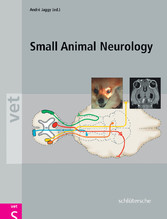Suchen und Finden
20 Parasitic Neurological
Diseases of the Dog and Cat , (S. 491-492)
Peter Deplazes
Various helminth and protozoal species are capable of infesting nervous tissue either transiently or permanently. The following overview includes information about a selection of clinically relevant parasites that affect the nervous tissues directly or indirectly via pathophysiological or immunopathological mechanisms.
20.1 Trypanosomiasis in the dog
General information and epidemiology: Trypanosomiasis of the dog is a rare imported disease. Trypanosomes in tropical Africa (Trypanosoma brucei and T. congolense) are transmitted by the tsetse fly, while in the subtropical areas of Africa, Asia and South America, T. evansi is transmitted by tabanid flies and Stomoxys spp. Dogs can also become infected by T. evansi by ingesting meat from infected herbivores. Another trypanosome species present in South and Central America is T. cruzi, which is transmitted by ticks, and is found in up to 30% of dogs and 20% of cats (Chaga’s disease).
However, as stated at the start, imported trypanosome infections are very rare. Clinical: Trypanosomiasis can be acute or chronic in the dog. In the acute form, the main symptoms are a febrile, rapidly deteriorating systemic disease causing a loss of condition, anaemia, leukopaenia, thrombocytopaenia, circulatory and respiratory symptoms, multiple generalised haemorrhages and oedema, conjunctivitis and corneal clouding (1, 2). Except for T. congolense, CNS symptoms can occur due to a meningoencephalomyelitis associated with the presence of extravascular trypanosomes (3). In such cases, death takes only a few days. Neurological signs may also occur as part of a chronic clinical picture and are determined by the location of the parasitic migration.
Diagnosis: The extracellular trypanosomes in the blood can be diagnosed by staining them in blood smears with Giemsa. Therapy: Treatment can be tried with quinapyramine sulphate (5 mg/kg, SC) or isomethamidium (0.25–1 mg/kg, IM). Both medications, however, are associated with severe side-effects (4).
20.2 Neosporosis in the dog
General information: The taxonomic position of Toxoplasma gondii and Hammondia heydorni are very close, while that of Neospora caninum, a species described in 1984, remains controversial (4, 5). Infection with N. caninum is increasingly associated with paralysis and death in the dog, as well as abortion and neonatal deaths in cattle and small ruminants.
The latest data convincingly demonstrate that N. caninum is one of the most important causes of abortion in cattle in Europe and is widely geographically distributed (6). Infections with Neospora have not as yet been reported in humans. Epidemiology: Using experimental infections, it has been shown that the dog can be a final host of N. caninum. In addition, naturally infected dogs have been shown to excrete Neospora oocytes (8). In comparison, the fox does not appear to be a suitable final host (9).
Alle Preise verstehen sich inklusive der gesetzlichen MwSt.











